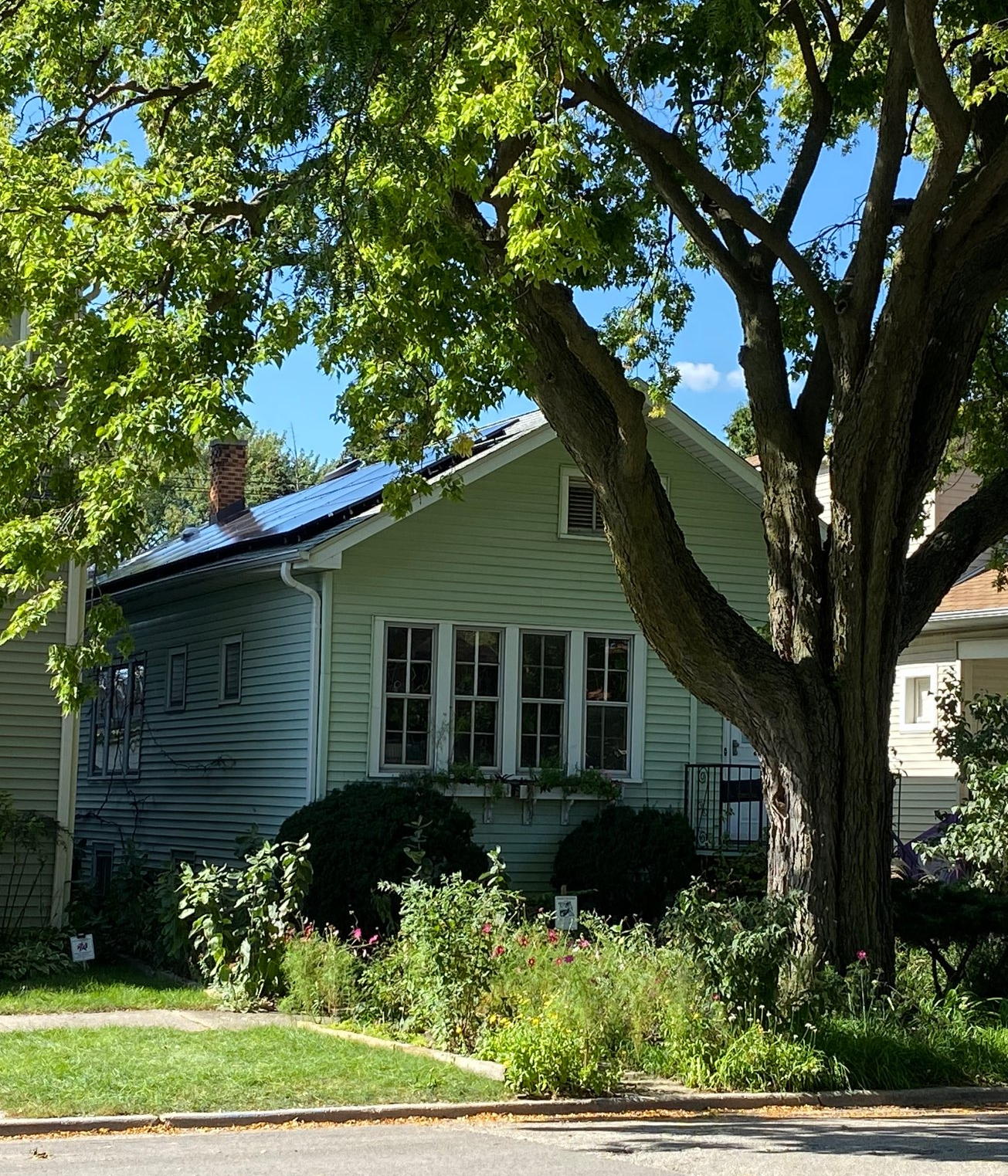
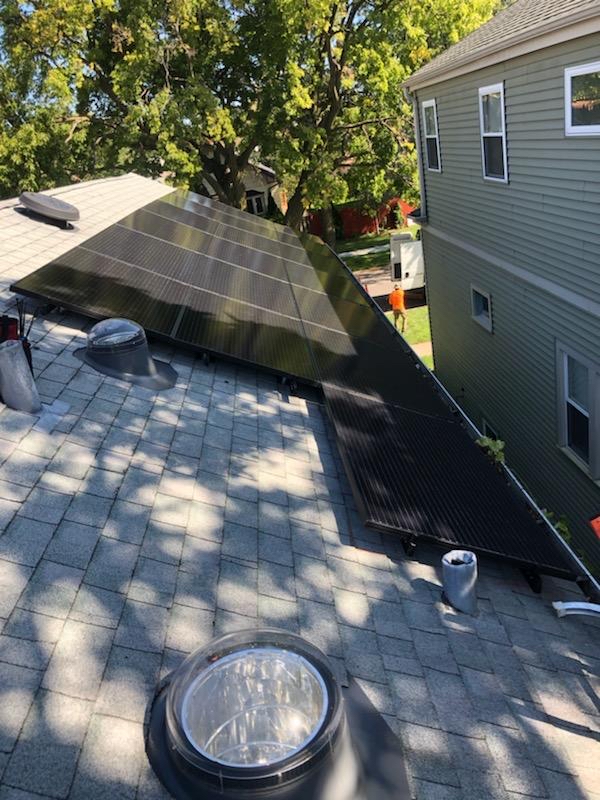
our latest adventures are documented in part 2
In
the early 2000s we were using about 10,000 kWh of power per year
(27 kWh per day on
average) for our 1,200 sq ft home and paying
$2,200 per year. After switching over to LED
bulbs, and more efficient appliances and HVAC we got that down
to 3,500 kWh per year (10 kWh per day on average), and $1,500 per year.
Then in 2017 we started using an electric car most of the time,
and in late 2018 added a second electric car, so we were using
electric cars for all our driving. That pushed our usage back up
to around 7,000 kWh per year (19 kWh per day on average)
and $2,300 per
year.
We
had been buying renewable power since 2014, and decided in July
2019 to switch over to generating our own power from solar. We
had been keeping track of the prices and performance since the
early 2000s and it seemed like the time had finally come that we
could produce enough power to offset our usage at a reasonable
price. People we knew had started installing solar at home so we
could get some pointers on the process. The federal tax credit
of 30% was also going to be reduced in 2020, so that motivated
us to get this done in 2019.
Over
a year we should produce about as much energy as we use, but we
will be producing more than we need in the summer, and less than
we need in the winter. Production will also vary with how much
sunlight we get. We are still connected to the grid. Forest Park
had smart metering installed years ago, so that means that any
excess energy we produce goes back through the smart meter into
the grid to help others and we get a credit. When we aren't
producing enough power we can pull power from the grid using the
credits we built up.
If
the power from ComEd goes out then we do not continue to get
power from the panels. Power from the solar panels is
automatically shut off as a safety measure for people working on
the power lines. However, if we add in a battery solution like a
Tesla PowerWall, then we would be able to use our solar system
during a power failure. More on this coming in the future.


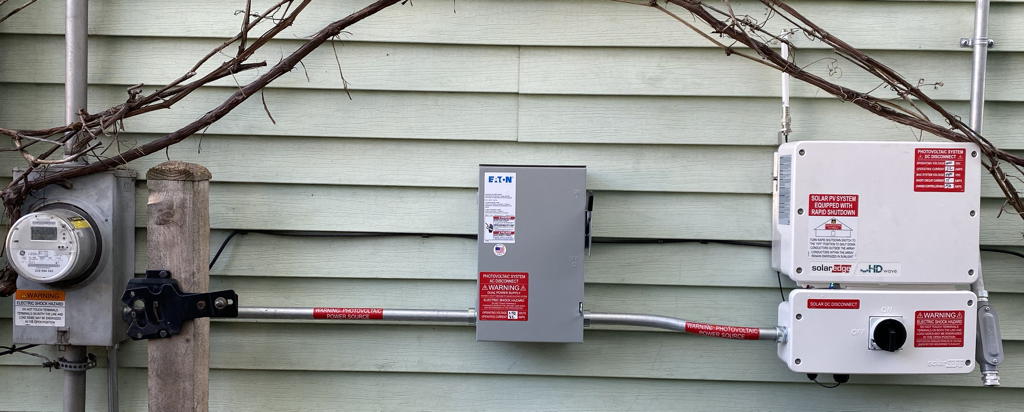
For Christmas 2020 we build a gingerbread
version of our house with the solar panels
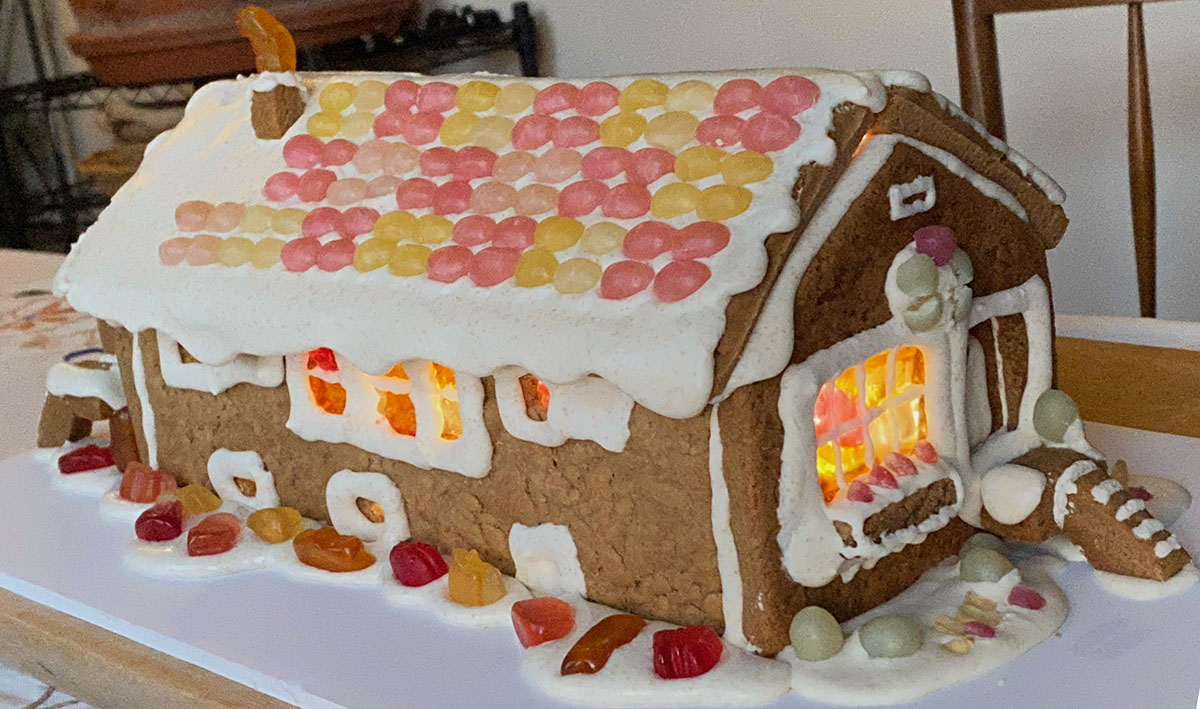
There
are several different ways to get solar installed, including
buying the system or leasing it. We decided to buy ours. The
size of the 'solar system' and its price are mostly based on the
amount of power you want to generate and available southern facing roof space,
but also on the potential rebates you want.
The
federal renewable energy tax credit for those buying a solar
system has been 30% from 2016-2019, but drops to 26% in 2020 and
down to 22% in 2021. Illinois has its Illinois Shines program in which you can get money up
front for installing solar in exchange for giving up 15 years
worth of Renewable Energy Credits from your system, but you can
only install solar up to 110% of what you used the previous
year. You can also choose to sell your Renewable Energy Credits
yourself over the next 15 years and install a bigger system, but
that seemed overly complicated.
We
had a 5.9 kW system installed, which should have offset 100% of
our usage from the last 12 months with 7,500 kWh of power
generation, though we've really only been getting about 4,800
kWh generated. This cost us a little over $20,500 up front, but
then we received
$6,500 back as part of the Illinois Shines program in early
2021, and we received over $6,100 back as a federal tax credit
on our 2019 taxes in 2020, so the entire system cost us around
$7,900.
We
still pay ComEd monthly ($15) for being connected to the grid.
We
figure in about 8 years the system should pay for itself.
| Jan |
Feb |
Mar |
Apr |
May |
Jun |
Jul |
Aug |
Sep |
Oct |
Nov |
Dec |
|
| 2019 |
(105) |
125 |
110 |
|||||||||
| 2020 |
90 |
210 |
360 |
595 |
630 |
675 |
660 |
590 |
385 |
280 |
165 |
105 |
| 2021 | 75 |
115 |
465 |
575 |
615 |
625 |
655 |
690 |
580 |
275 |
165 |
115 |
| 2022 |
60 | 215 | 475 | 545 | 640 | 740 | 690 | 655 | 550 | 415 | 170 |
80 |
| 2023 |
85 |
280 |
485 | 670 |
780 |
740 | 740 | 680 | 495 |
325 |
190 | 95 |
| 2024 |
75 | 380 | 545 | 635 |
760 |
Our panels produce roughly six times as much energy per month
(in kWh) in the summer as in the winter with the longer daylight
hours and the sun being higher in the sky (especially with the
two story house to the south of us).
The numbers for 2020 (4,750
total) are lower than expected. Apparently Illinois has been
much cloudier than usual this year according to the Illinois
climate network. In 2021 we made it almost to 5,000. In summer
2021 a tree in the yard to the south of us was cut down and that
probably helped our numbers in 2022 to get up above 5,200.
ComEd's
'View My Usage' on their web page or smart phone app gives data
on production and usage with a day or two delay, so we can see
an overview of how our system is working. We have a relatively
constant background use of power (blue) but during daylight
hours our energy production (green) is enough to offset that
usage and supply excess power back to the grid.
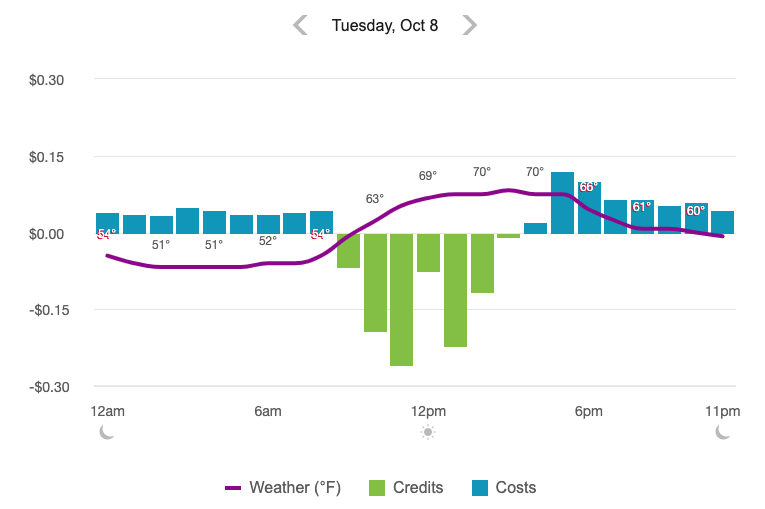
We can also see live data
from the system itself showing how production varies over time
and how much each panel is producing.
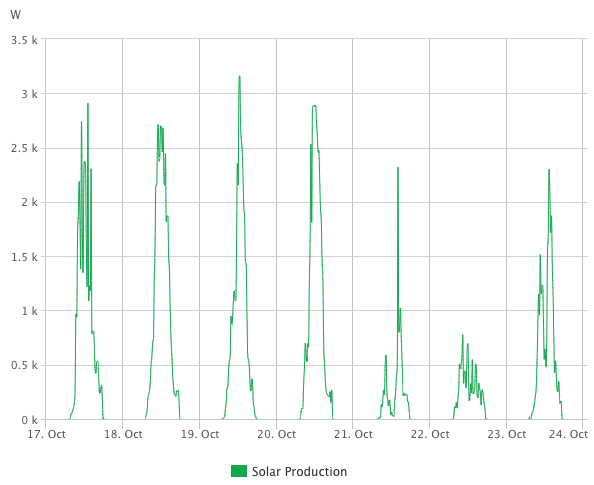
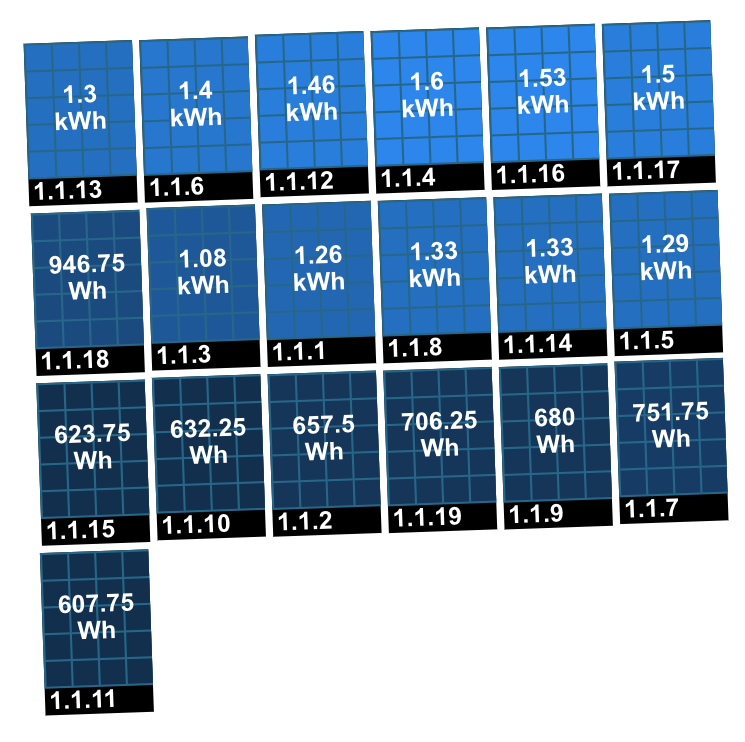
Another nice device for this
kind of thing is the Rainforest Automation Eagle-200 which can
wirelessly connect to our utility meter and to our home WiFi for
real-time monitoring of the to-grid and from-grid power through
a web page or mobile app/
Since
Illinois has net metering and our electricity rates aren't crazy
expensive here, adding in a battery like Tesla's Powerwall isn't
needed from an economic point of view, but it does allow us to
use more of the excess power that we are generating by storing
it for later usage (minus a 10% loss in the conversion), rather
than sending it to the grid and then using grid power at night.
Adding a battery also allows us to keep running if there is a
neighborhood power failure and grid power is unavailable,
although we haven't had any serious power failures here for many
years.
We started the process for getting a single 13.5 kWh Tesla Powerwall 2 in early November 2019 after our solar system went live. In early February 2020 we had the contract and the installation took place in early May 2020. The total cost was $12,000 including changes to our circuit breaker box, and we were able to get 26% of that back on our taxes in Spring 2021 (and since we ordered in 2019 Tesla gave us the 4% we missed as the Federal rebate decreased, getting us back to the 30% federal rebate from 2019) bringing the final cost down to $8,400. Our entire house is connected to the Powerwall but the Powerwall can only generate 5kWh maximum at a time. That should be OK as the only thing that draws that much power is recharging the Tesla. The install took most of a day and added three more boxes with red stickers to the side of our house.
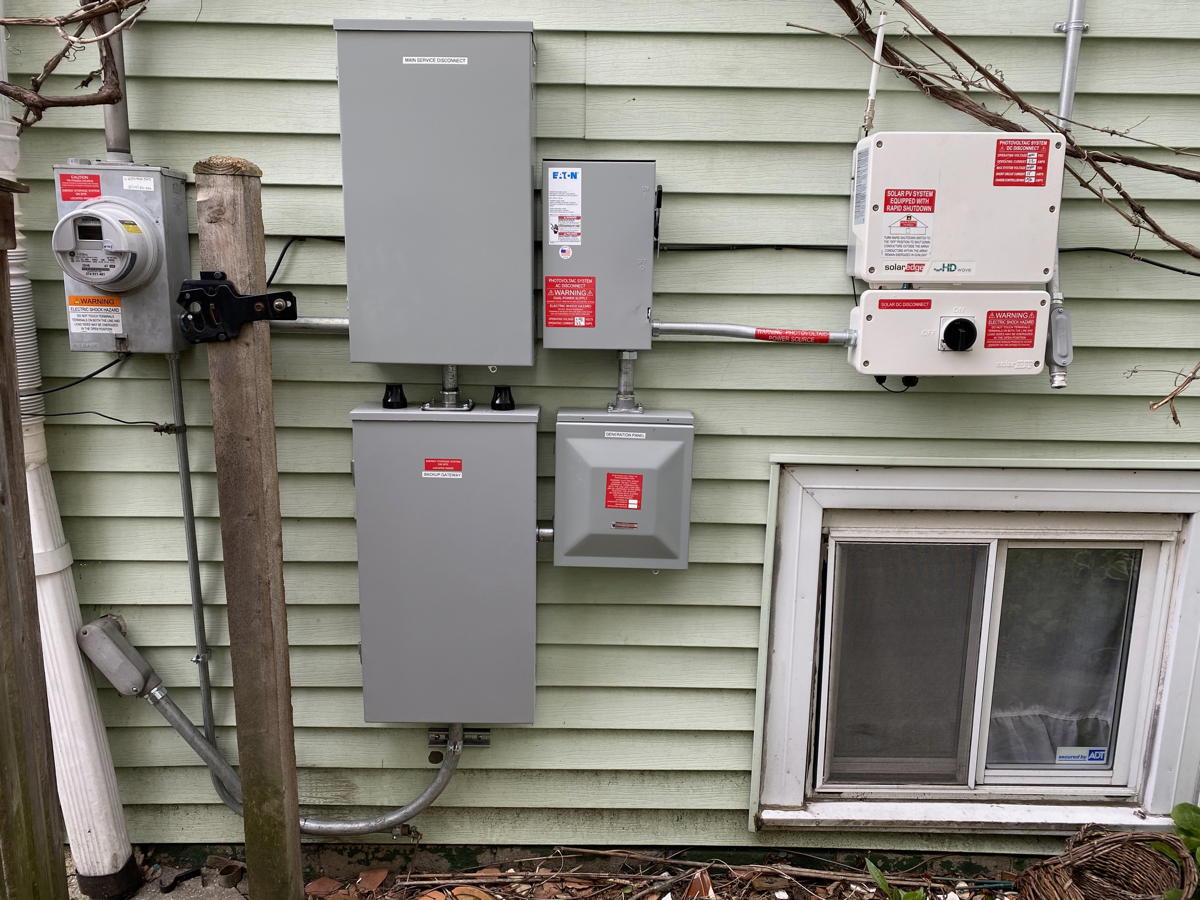
The
Powerwall itself is sitting in our basement. Its very quiet and
has a green glow in the dark.
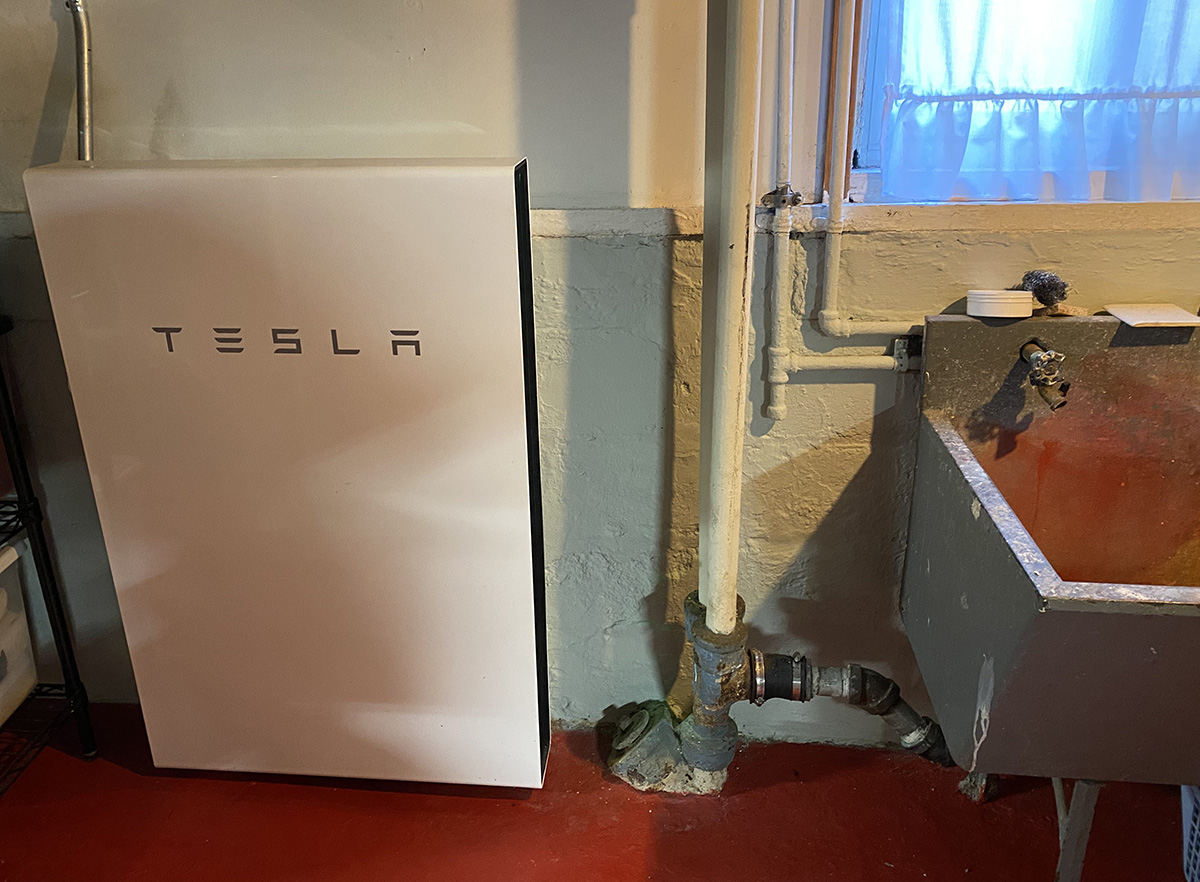
The
Powerwall is connected to our home WiFi and we can monitor it
from the very nice Tesla app. Here the app shows a typical
spring day. The Powerwall (green) supplies power to the house
through the night, then the solar (yellow) starts to producing
in the morning and begins powering the house and also recharges
the Powerwall until it is full at mid-day. Then the excess solar
power goes out to the grid (grey) for the rest of the afternoon.
As the sun begins to set the Powerwall takes over again for the
rest of the night, giving us an entire 24 hours without relying
on grid power. In early May 2020 we were able to go 11 days
straight, and in mid July 22 days straight without needing power
from the grid until a couple days in a row with storms drained
the Powerwall.
- Google's Project Sunroof -
https://www.google.com/get/sunroof
- Illinois Shines program
- http://illinoisshines.com/
- Home Energy Tax Credits - https://www.irs.gov/credits-deductions/home-energy-tax-credits
- Homeowner’s Guide to the
Federal Tax Credit for Solar Photovoltaics - https://www.energy.gov/eere/solar/homeowners-guide-federal-tax-credit-solar-photovoltaics
- Tesla Powerwall -
https://www.tesla.com/powerwall
- NREL's PVwatts Calculator - https://pvwatts.nrel.gov/pvwatts.php
- Rainforest Automation
EAGLE-200 manual -
https://rainforestautomation.com/wp-content/uploads/2017/10/EAGLE-200-user-manual-1.00.pdf
last updated May 31, 2024